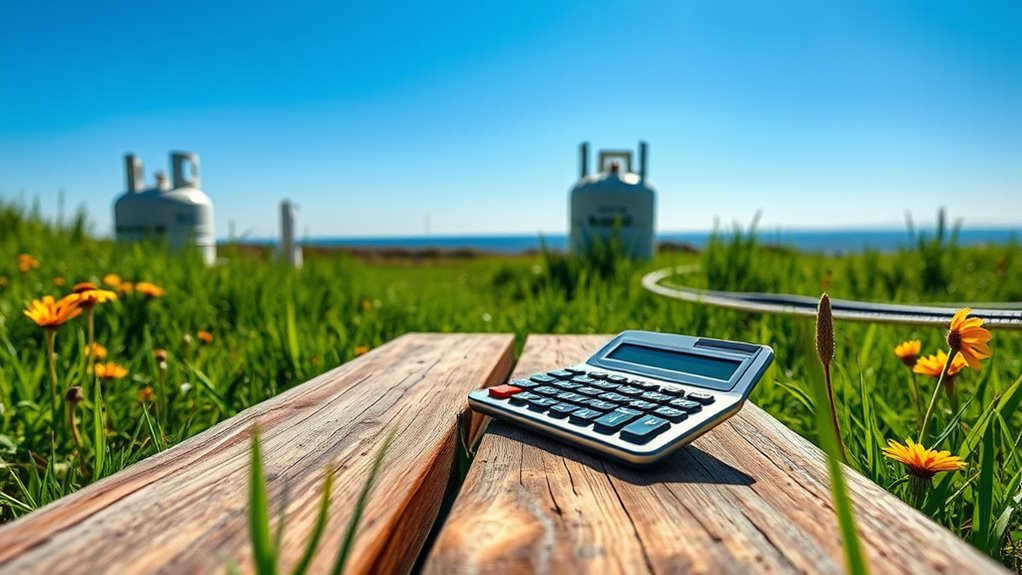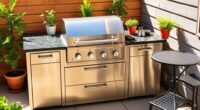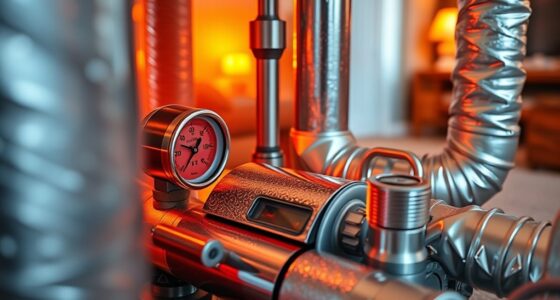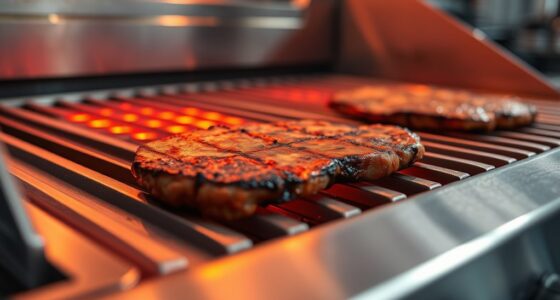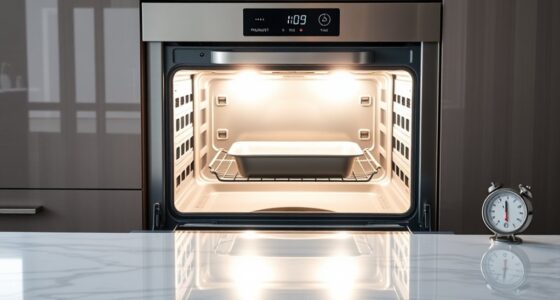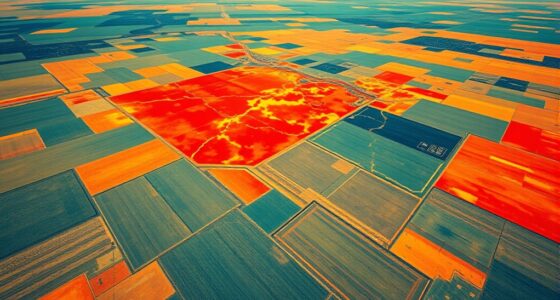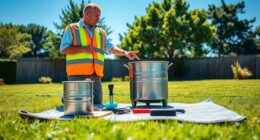To stop guessing, start by understanding the differences between propane and natural gas, including costs, appliances, and benefits. Measure your energy needs accurately by calculating your space’s size and appliance requirements. Use a calculator by inputting your energy consumption, local fuel prices, and safety tips to compare costs effectively. Analyzing these results helps you choose the best outdoor fuel option for your needs. Keep exploring to get expert insights on making the most informed decision.
Key Takeaways
- Use the calculator by inputting your appliance’s BTU or therms to compare fuel costs accurately.
- Enter local fuel prices for propane and natural gas to determine the most economical option.
- Consider safety tips like proper installation, ventilation, and appliance compatibility when choosing fuel types.
- Analyze total long-term costs, including installation, operation, and maintenance, for an informed decision.
- Optimize outdoor setup by weatherproofing appliances, inspecting connections, and following safety guidelines.
Understanding the Basics of Propane and Natural Gas

Propane and natural gas are two common fuels used for outdoor heating, grilling, and other applications, but they differ in their sources and properties. As fuel types, propane is a versatile liquid stored in tanks, while natural gas is a gaseous fuel supplied through pipelines. This distinction affects appliance compatibility; some outdoor appliances are designed specifically for propane, requiring special connectors or adjustments, while others are compatible with natural gas. Knowing these differences helps you choose the right fuel for your setup. Propane offers portability and is ideal where natural gas lines aren’t available, whereas natural gas provides a continuous, cleaner-burning supply. Understanding these basic distinctions ensures you select appliances compatible with your chosen fuel type, optimizing safety and performance. Additionally, the cost differences between propane and natural gas can influence your ongoing expenses and installation choices.
How to Accurately Measure Your Energy Needs

To guarantee you select the right amount of fuel for outdoor heating or grilling, you need to accurately measure your energy needs. Start by evaluating the size of the area you want to heat or the cooking space required. Consider the BTU (British Thermal Units) needed—larger areas demand higher BTU ratings. This helps you determine the appropriate fuel capacity, ensuring ideal fuel efficiency. Keep in mind that different appliances vary in energy consumption, so check manufacturer specifications. Doing this precise measurement allows for a clear cost comparison between propane and natural gas, helping you avoid unnecessary expenses. Additionally, understanding the role of automation in business can help streamline your purchasing and monitoring processes, making fuel management more efficient. By understanding your exact energy requirements, you can choose the most efficient and cost-effective fuel source, maximizing performance while minimizing waste.
Step-By-Step Guide to Using a Propane Vs Natural Gas Calculator

Using a propane vs natural gas calculator is a straightforward way to compare fuel options for your outdoor needs. To start, input your estimated energy consumption, such as BTUs or therms, into the calculator. Next, enter current fuel prices to get an accurate fuel cost comparison. Be sure to consider safety considerations, like proper installation and ventilation, when choosing your fuel. Here’s a quick overview:
| Step | What to Do | Why It Matters |
|---|---|---|
| Measure Your Energy Needs | Input your outdoor appliance’s energy use | Ensures accurate comparison |
| Enter Fuel Prices | Update with local propane and natural gas rates | Reflects true costs |
| Review Safety Tips | Check safety considerations for each fuel type | Prevents hazards |
| Analyze Results | Compare cost and safety info | Informs your decision |
This process helps you make informed, safe choices based on real data. Understanding the differences between propane and natural gas can further guide your decision-making process.
Interpreting the Results to Make an Informed Choice
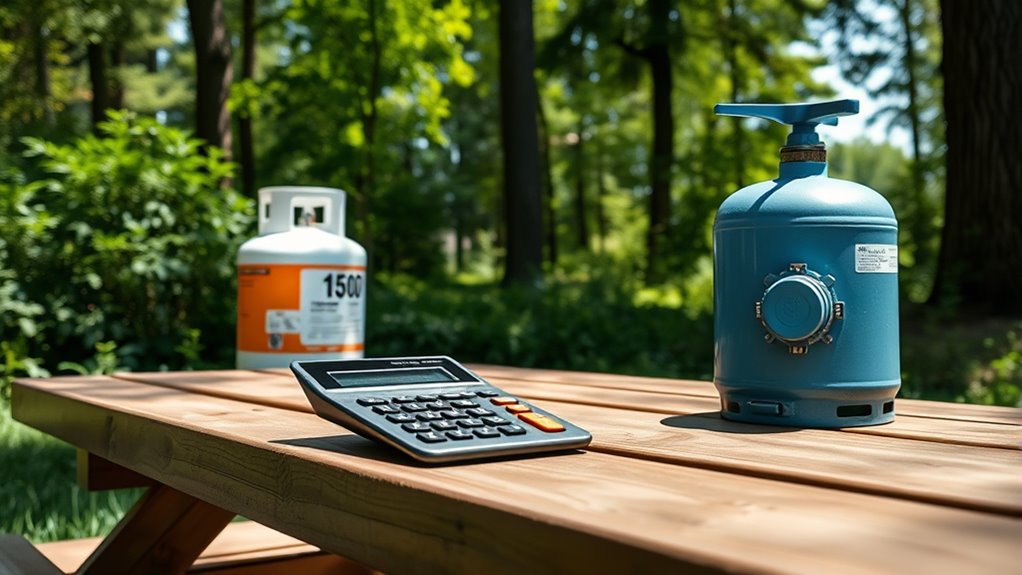
Once you’ve reviewed the comparison results from your calculator, it’s essential to analyze both the cost comparison and safety considerations carefully. Look at the total costs for propane and natural gas over time, including installation and ongoing expenses, to determine which option fits your budget better. Additionally, consider the environmental impact—natural gas generally produces fewer emissions, making it a greener choice. Safety is also vital; evaluate the risks associated with each fuel type, such as leaks or fire hazards. Use these insights to weigh the long-term savings against environmental benefits and safety concerns. Making an informed decision means balancing your budget, safety, and sustainability priorities to select the most suitable outdoor fuel for your needs. Incorporating ventilation considerations into your planning can further enhance safety and efficiency.
Tips for Optimizing Outdoor Heating and Cooking Efficiency

Maximizing outdoor heating and cooking efficiency requires smart planning and regular maintenance. Weather considerations play a vital role—you should check forecasts before using your setup to avoid waste and hazards. Shielding your appliances from wind and rain helps maintain consistent heat and reduces fuel consumption. Additionally, ensure safety precautions are in place, such as keeping flammable materials away and properly ventilating the area. Regularly inspect hoses, connections, and burners to prevent leaks or malfunctions. Using the right size equipment for your space minimizes energy waste. Proper placement of heaters and grills ensures even heat distribution, saving fuel and enhancing safety. Implementing appropriate filtration systems can also improve indoor air quality and reduce dust buildup around your outdoor cooking area. By paying attention to weather and safety, you can optimize performance, extend equipment life, and enjoy more efficient outdoor cooking and heating.
Frequently Asked Questions
Can I Convert My Existing Outdoor Appliances Between Propane and Natural Gas?
Yes, you can convert your existing outdoor appliances between propane and natural gas, but it requires proper appliance conversion and ensuring fuel compatibility. You’ll need the right conversion kits and possibly adjustments to the regulator. Always check with the manufacturer or a professional to confirm that your appliances are eligible for conversion and that all parts are compatible with the new fuel type. Never attempt conversion without expert guidance.
What Safety Precautions Should I Consider When Switching Fuels Outdoors?
Think of switching fuels as dancing with fire—be cautious and in sync. You should prioritize fire safety by checking for leaks and ensuring proper ventilation requirements outdoors. Always turn off the gas supply before making adjustments, and use approved connectors. Keep a fire extinguisher nearby, and never rush the process. Staying vigilant and following safety guidelines guarantees your outdoor space remains safe and enjoyable, no matter which fuel you choose.
How Do Local Regulations Impact Outdoor Propane and Natural Gas Installations?
Local regulations greatly impact your outdoor propane and natural gas installations. You need to check zoning restrictions that may limit where you can set up tanks or appliances. Additionally, permit requirements might apply, ensuring safety and compliance with code standards. Failing to follow these regulations can lead to fines or unsafe conditions. Always contact your local authorities or building departments before starting your project to ensure you meet all zoning and permit criteria.
Are There Environmental Differences Between Using Propane and Natural Gas Outdoors?
While both fuels burn cleaner than many alternatives, natural gas generally offers a lower environmental impact due to its cleaner emissions. Emission differences reveal natural gas produces fewer greenhouse gases and pollutants, making it a more eco-friendly choice outdoors. Propane, though still relatively clean, releases more carbon dioxide and other emissions. Your choice impacts air quality and climate, so consider these environmental differences when deciding which fuel to use outdoors.
What Are the Long-Term Cost Implications of Choosing Propane Over Natural Gas Outdoors?
Choosing propane over natural gas outdoors impacts your long-term costs. Propane often offers better cost efficiency if you have limited or no natural gas access, but maintenance costs can be higher due to tank refills and potential equipment upkeep. Natural gas tends to be more economical over time with consistent use, thanks to lower fuel prices and fewer maintenance needs. Your decision should consider your usage patterns and available infrastructure.
Conclusion
Now that you understand how to compare propane and natural gas accurately, you can make smarter choices for outdoor heating and cooking. While one offers convenience and affordability, the other provides cleaner energy. By using the right calculator, you avoid guesswork and guarantee maximum efficiency. Whether you prioritize sustainability or cost, the right decision enhances your outdoor experience—so don’t leave it to chance. Take control, compare wisely, and enjoy your outdoor space to the fullest.
